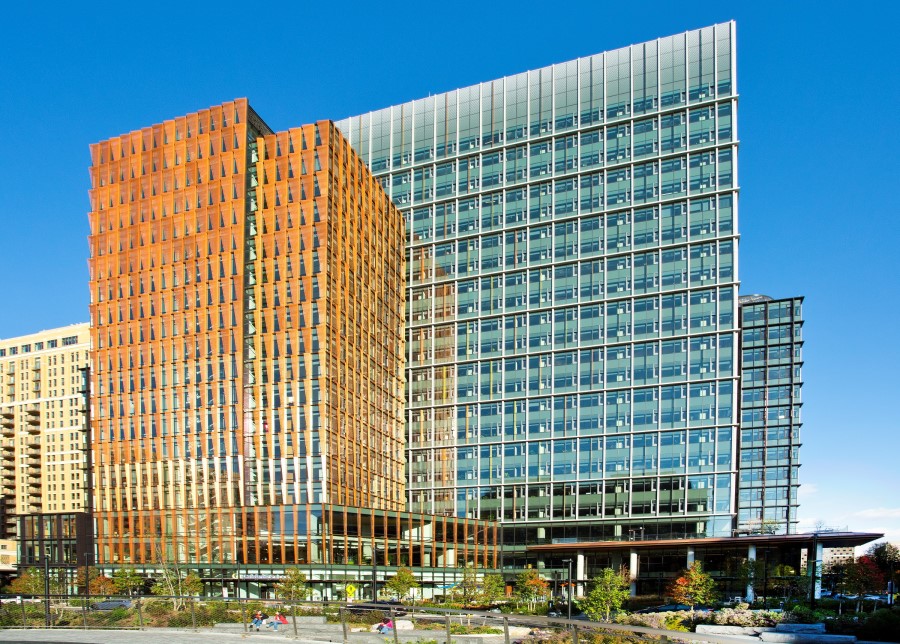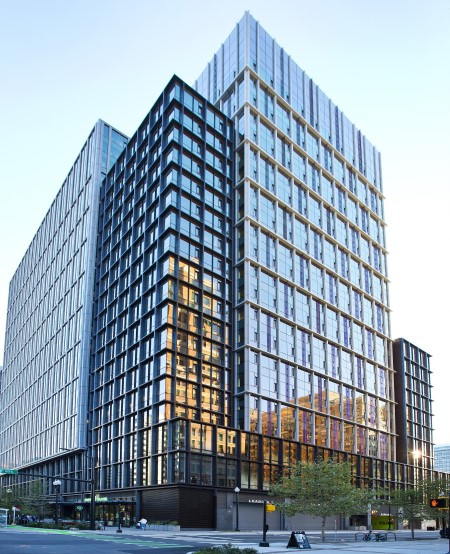
Amazon’s new headquarters, featuring a pair of glass-clad towers, is transforming the skyline in Arlington, Virginia, and enhancing the neighborhood with open-to-the-public ground-floor lobbies and an expanded Metropolitan Park. As the world’s largest LEED Platinum-certified complex, the 22-story Harmon and Merlin towers will house 14,000 employees engaged in e-commerce, cloud computing, digital streaming and artificial intelligence.
Vitro products featured
The towers feature Solarban 72 Starphire glass curtainwall by Vitro Architectural Glass. “The low iron content makes it extremely clear without the green tint common in high-iron glazing,” says Brian Earle, principal at ZGF Architects. The 13-foot by 5-foot curtainwall modules include a 7 foot, 6-inch-tall vision panel and a 5½-foot-tall spandrel section, customized to create a variety of wall types that visually reduce the buildings’ perceived mass.

Between the two buildings, 3,008 custom single-hung operable Solarban 72 Starphire glass windows, developed with Harmon and Wausau, feature integrated bug screens that retract into the sill when closed. Additionally, a 35-foot-tall picture window with a 2-inch-thick acoustical layup fronts the large event center. Solarban 72 Starphire glass provides superior solar control, allowing 68% of visible light to pass through while blocking 72% of the sun’s solar rays.
Daylighting
To maximize daylighting, the building form incorporates deep setbacks and perforated copper-colored fins attached to scalloped light louvres on west-facing amenity zones. Skylights were added where site constraints required deeper floorplates on the lower levels. The podium cladding, made of charcoal-colored terracotta, references the site's historic use as a brickyard, while the Merlin building features metal fins with a pearlescent coating and the Jasper tower displays iridescent, dichroic glass that changes color with the sun.
Meeting Metropolitan Park’s aggressive performance goals, including energy savings 24% below the ASHRAE baseline, the glazing played a crucial role. “The vision panel, spanning from 30 inches to 120 inches above the finished floor, is optimized to provide ample daylight throughout the work areas,” says Earle. The top 2 inches of the panel features an integral light shelf that directs daylight up to 50 feet into the building, providing daylight autonomy for 88% of occupied areas. Integrated photometric controls adjust the electrical lighting to reduce loads.
The lighting louvers were engineered with roller shades and sightlines to eliminate glare, ensuring ample light penetrates the space even when shades are drawn. Spandrels above and below the vision panels provide additional insulation. ZGF selected a custom gray color for the spandrels to blend seamlessly with the vision panels, enhancing the buildings' vertical expression.
Bird-friendly and sustainable
Given the building’s proximity to the Potomac River, a major bird migratory corridor, the architectural team designed the façade with bird-friendly elements. A combination of terracotta, metal and glass fins enhances visibility for birds, while the lower levels feature Walker Glass’s AviProtek E pattern 216, a bird-friendly glass solution with acid-etched visual markers and Solarban 72 solar control, low-e coating by Vitro.
The all-electric buildings are highly sustainable, powered by 100% renewable energy from an off-site solar array, using 50% less water than required by code, and incorporating biophilic design principles to enhance occupant well-being. The towers include 19 rooftop terraces, eight of which are occupiable. One terrace, the farm terrace, allows Amazon employees to grow herbs and vegetables for donation to community organizations. The complex also features over 50,000 square feet of retail space for local businesses and a 2.5-acre public park.
